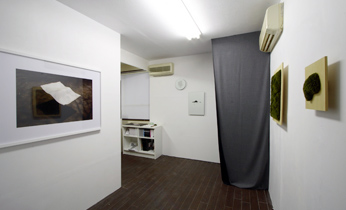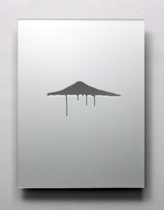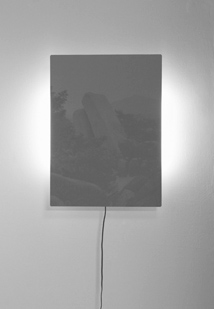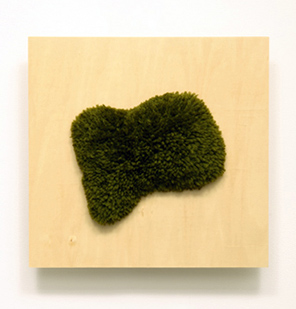 |
|
 |
Installation view: "Ryohei Usui Exhibition: Flying goza mat," Mujin-to
Production, Tokyo, 2008
Photo: Kei Miyajima |
|
Ryohei Usui, "Bedewing (Mountain)," 2008, sandblasting on mirror
© 2008 Ryohei Usui |
The work of young artist Ryohei Usui, who was born in Shizuoka in 1983 and presently lives and works in Tokyo, is perfectly suited to the gallery/"production company" known as Mujin-to Production. Situated in the local neighborhood of Koenji, the exhibition space itself is no larger than a small Tokyo-size apartment -- yet the focus of the program run by former Mizuma Gallery director Rika Fujiki and critic Nami Sezawa extends beyond the standard concept of a gallery within a space. Perhaps most representative of Mujin-to's aim is their most successful artist, actually a collective known as Chim Pom. The gallery distributes -- amongst other items -- Chim Pom tee-shirts and DVDs, and at one point hosted an auction related to these artists' activities; all of this is interesting insofar as it points to a particularly Japanese, particularly Tokyo contemporary art aesthetic. This aesthetic is shared with Ryohei Usui.
Usui's work may be divided into two categories: those pieces executed in a variety of media that picture "Japanese" objects -- both iconic and mundane -- in an uncanny or even impossible situation, and those works utilizing the material of green carpet and panel to isolate and examine an abstract "Japan" as a particular geographic entity -- an island.
The present exhibition consists of a single straight photographic work, "Flying goza mat," which presents an image of an everyday Japanese object -- a goza mat -- in anything but an everyday situation: the goza mat extended and hovering impossibly over the ground. Rather than consider the image as a symbol or metaphor -- this would seem out of keeping with one aspect of the artist's down-to-earth intentions -- it perhaps makes sense to look with a bit more care. What Usui has photographed, without the aid of digital manipulation, is a simple fact, that of an object in a moment of floating. Usui avoids a possible cliche reading by adopting a matter-of-fact perspective that infuses the image with both literal wonder and a gentle dose of humor.
Additionally, the exhibition includes a new series of frosted-mirror panels. It is possible to view one's reflection only in a polished portion of each panel; however, the clear portion of the mirror is not a neutral shape but, rather, a recognizable image. In one mirror the reflective section is in the shape of a dripping Mount Fuji; in another it is an abstract yet clearly delineated shape. Referencing the light touch of a steamy bathroom doodle as well as the more weighty tradition of mystical language which identifies the polished mirror as a site of consciousness, the works playfully inject the everyday into a possibly obtuse realm.
Two green-carpet-on-panel works are also installed side by side within the exhibition space. These panels, at once paintings and abstract maps, are the exhibition's only symbols, insofar as abstractions function in a symbolic manner. As stand-ins not only for an island in general, it is tempting to read these works as highly contemporary abstract representations of the artist's home country of Japan. As such, these simple works, however mute, generate a stubborn resonance.
Finally, hidden in a small corner wall in the back of the Mujin-to space hangs a modest, backlit photograph. The image, grey to the point of near invisibility, pictures an unpopulated formation of rocks. A sign-board, the piece points beyond the exhibition in both a literal sense -- the piece has a certain melancholy which may signal a new direction in Usui's practice -- and a metaphorical one. Mujin-to and its artists aim for a point beyond the gallery; if they are successful, exhibitions presented in spaces -- such as Usui's present show -- face possible obsolescence.
 |
|
 |
Ryohei Usui, "Gray Sign," 2008, lambda print, CCFL lamp
© 2008 Ryohei Usui |
|
Ryohei Usui, "Uninhabited Island," 2008, yarn, felt, wood
© 2008 Ryohei Usui
All images courtesy of Mujin-to Production, Tokyo |
|